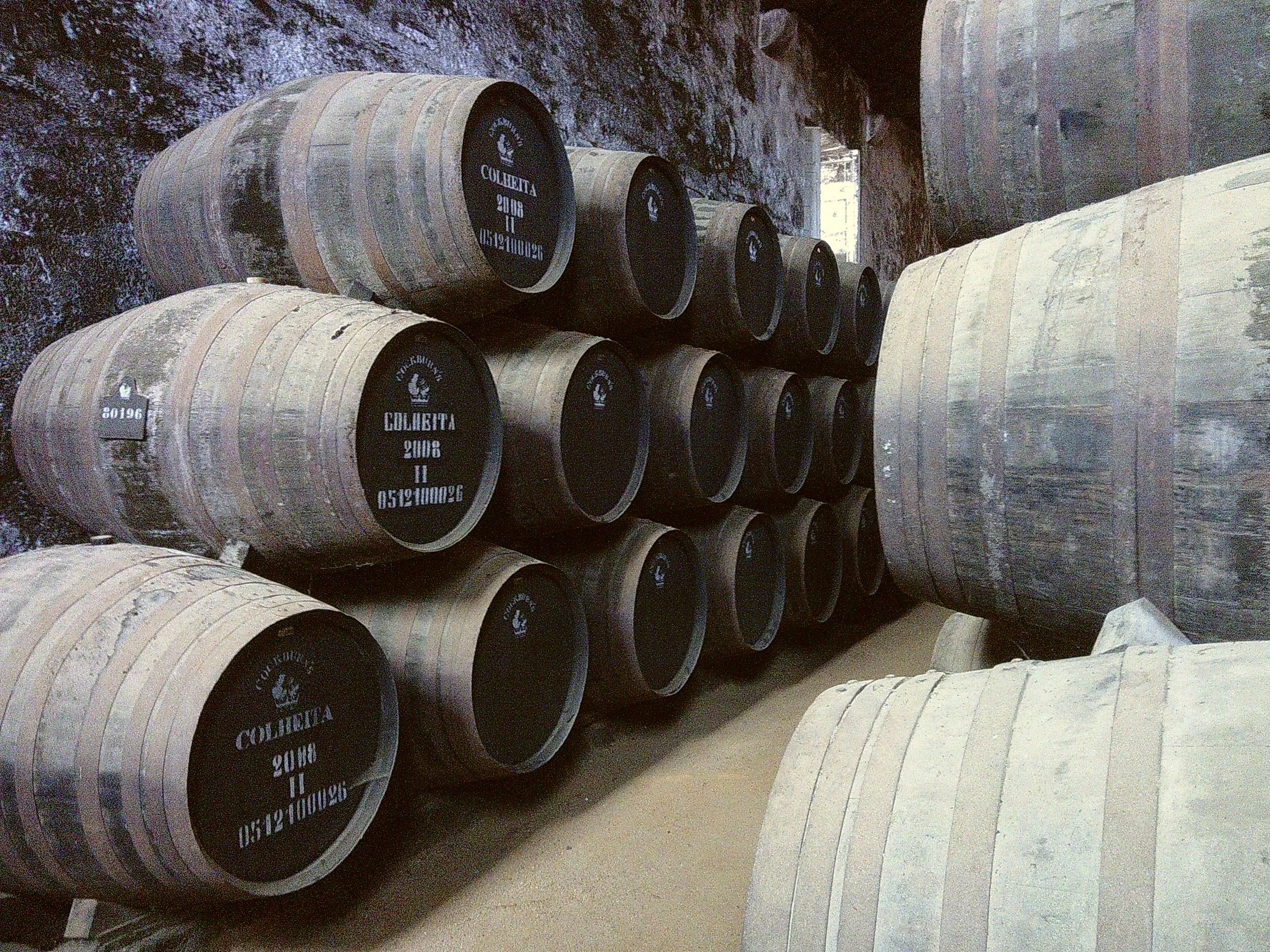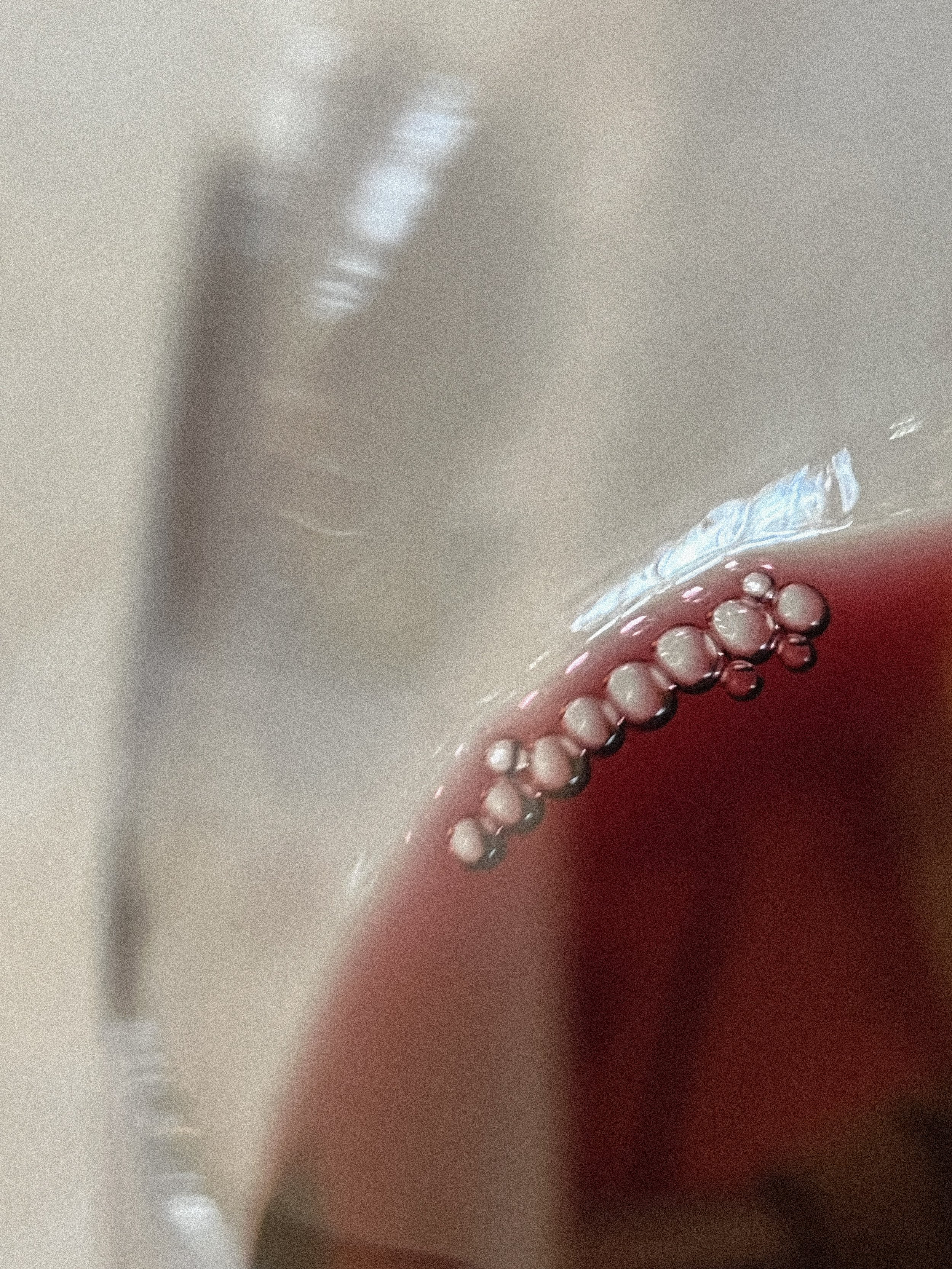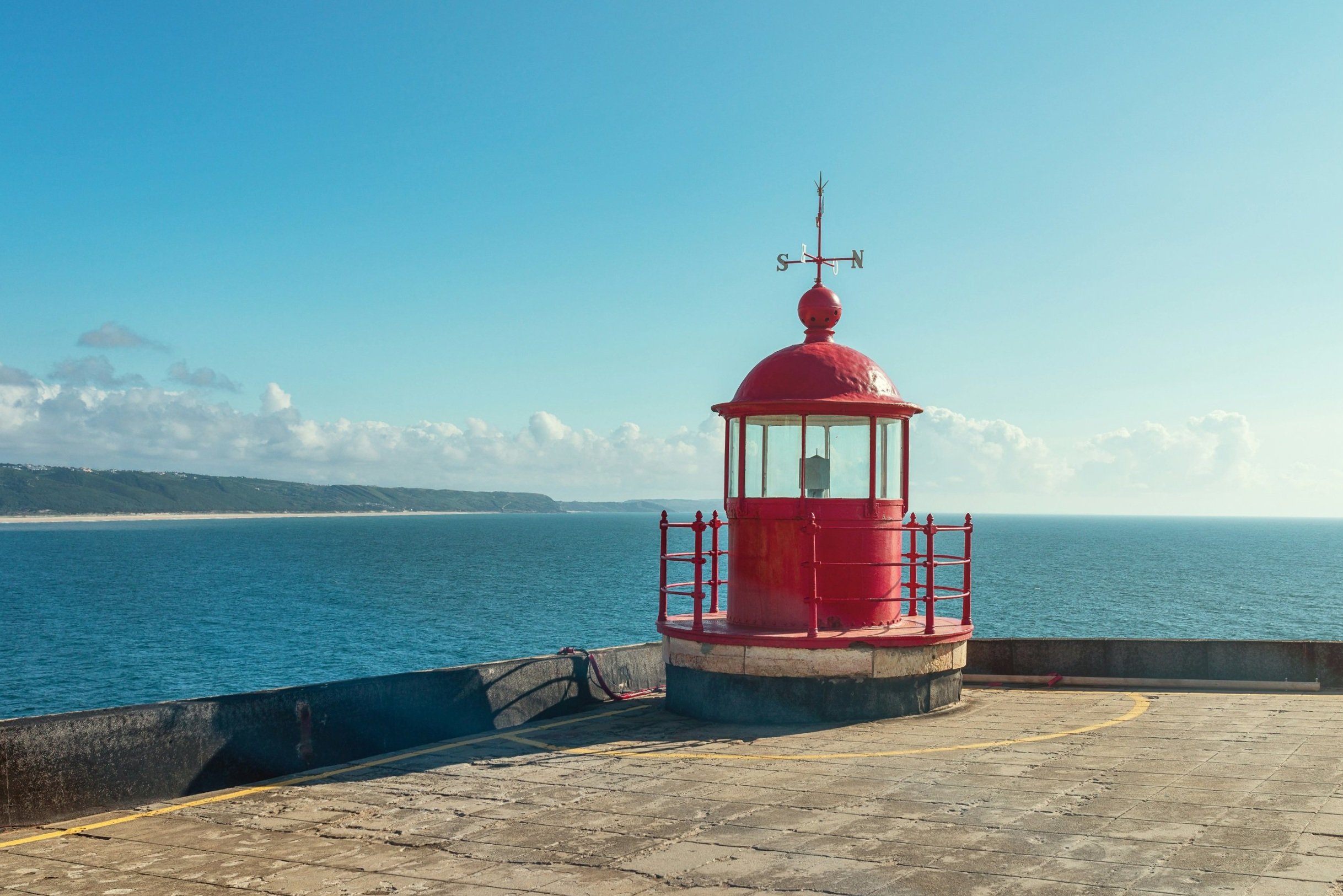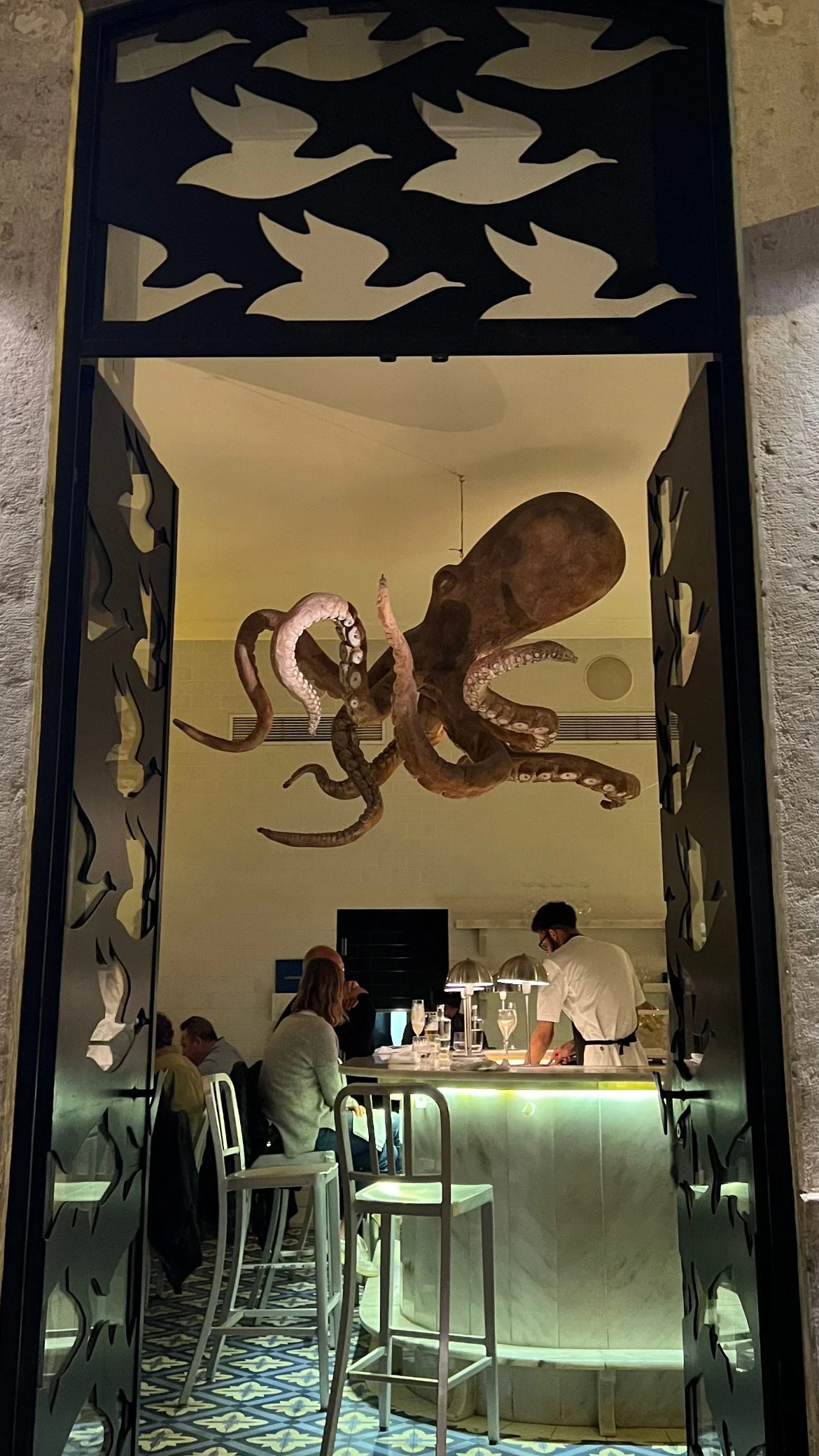
Portugal wasn’t on my list—not because I didn’t want to go, but because I didn’t yet know I needed it. The invitation came wrapped in family when my partner’s extended family planned a special gathering and I was lucky enough to be folded into the mix. What started as a vacation turned into a slow unfolding of a country that feels both familiar and elusive, like a half-remembered dream or a melody you’re sure you’ve heard before.
Each place we visited stitched itself into me differently. This is a travelogue to a country that welcomed me not just with open arms, but with full plates, long toasts, and the kind of conversations that only happen when you linger.
Porto is a city draped in sea mist where blue-and-white azulejos guard every crumbling corner like weary sentinels. But don’t mistake the melancholy for sleepiness. Beneath the ceramic tiled facades and baroque balconies, there’s a pulse—funky, flavorful, and just a little decrepit. This is a place where salt cod (bacalhau) gets reinvented with Michelin finesse, where record shops double as altars to analog rebellion, and where even your hotel feels like a love letter to faded grandeur and Atlantic blues. Porto hums, and if you’re lucky, you’ll tune in.
Amarante feels like a town dreamed up after a bottle of wine—lush, green, and draped over the banks of the Tâmega River like it’s been lounging there for centuries. Stone bridges, baroque churches, and the sort of calm that slows your step without asking. There’s a cannonball from Napoleon’s failed invasion still lodged in the church façade, a defiant souvenir of a town that doesn't flinch. And then there are the pastries—papos de anjo, soaked in syrup and sin, served by bakers who look like they’ve been making them since the French packed up and left. Magic dusted in sugar.
Confeitaria da Ponte sits right by the river, charmingly unassuming, but inside it’s a pastry temple that takes its sugar very seriously. Their São Gonçalos (pictured), named after the town’s beloved saint, are soft, golden confections that taste like tradition wrapped in indulgence. But don’t leave without one of their giant palmiers. They casually claim it’s the best in the world, which sounds like bluster until you bite in—shattering layers of caramelized puff pastry that somehow manage to be both crisp and chewy. I didn’t know there was a global competition for palmiers, but if there is, this one’s already won.
Just a few steps down the hill from Confeitaria da Ponte, there’s a modest little Frutaria that most tourists breeze past, which is a mistake. Inside, it’s a riot of color and smell—fresh greens that look like they were plucked that morning, tomatoes and peppers the size of a baby’s head, glossy and absurd in the best way. Tucked among the produce, you’ll find bags and bags of roasted nuts that are shockingly addictive. Keep walking downhill and you’ll stumble on a shop selling local cheeses so fresh and funky they could tell you the name of the cow.

Douro Valley is where vineyards stretch like a never-ending patchwork quilt, clinging to hillsides with river bends that made time feel irrelevant. This is Portugal distilled to its most elemental: earth, sun, stone, and time. The Douro doesn’t care if you’re impressed—it’s been doing this long before you showed up.
In the Douro Valley, we stayed at Quinta de Cima, a private villa tucked between the vines, where two local women cooked us rustic, soulful Portuguese meals—outstanding bacalhau, a tomato, watermelon and feta salad I never saw coming, and chocolate mousse drizzled with orange-zested olive oil that tasted like a grandmother’s secret—all paired with wine grown just steps from the kitchen. It was the kind of warm, generous hospitality that stays with you long after you’ve left. A true treat in every sense.
At Quinta Nova, the wine tour winds through centuries-old cellars and sun-drenched vineyards, where the terroir speaks louder than any guide. It all leads to Terraçu’s Restaurant, where Chef André Carvalho serves an indulgent, multi-course lunch inside a warm, intimate space perched above the valley. Each dish arrives with a glass of perfectly paired wine, and through the windows, the Douro River glints below like a quiet witness to the feast. It’s the region on a plate with a view to match.

Nazaré is a mood, a reverberation of salt air, sweat, and surfboard wax. This once-sleepy Portuguese fishing village has transformed into a global pilgrimage site, thanks in no small part to pro big wave surfer Garrett McNamara who stared down a monstrous wall of water here and rewrote the boundaries of what a human being can ride. Since then, surfers from every corner of the globe have come chasing his wake, hoping to carve their names into a 100-foot wave. On the right day, the horizon isn’t just a view, it’s theater. Big wave season turns this perch into a coliseum, the Atlantic into a beast, and the surfers below into mad poets scribbling lines in water. Nazaré is adrenaline, mythology, and raw Atlantic power, crashing in endless cycles.
Restaurante A Celeste is no-frills, no-small-talk dining at its most unapologetic. Don’t expect smiles, and beware of surprise trays of food dropped on your table without warning—they're extras, not mistakes. But the payoff? Chef Celeste’s homey and fresh dishes that hit the spot. Go for the grilled sardines or bacalhau, served with buttery garlic potatoes drizzled in local olive oil, and migas—a rustic mix of bread, garlic, and greens that’s as comforting as it is classic. Don’t skip “the best arroz doce (rice pudding) in the world,” according to McNamara. Overall, it’s a get-in, get-fed, get-out kind of place, and sometimes that’s exactly what you need.
After lunch, hike up to the cliffside of the 16th century Forte de São Miguel Arcanjo to the Farol de Nazaré. Sure, it’s touristy—mostly full of people speaking everything but Portuguese holding selfie sticks, and surrounded by souvenir stands galore, but what can you do? This is the spot. The iconic view from the red lighthouse, where in big wave season, surf fans crowd the edge with cameras and long lenses waiting to catch a glimpse of history in motion. It’s part spectacle, part ritual, and when those waves roll in, all the noise fades.
Lisboa is a slow, smoldering love affair wrapped in the scent of grilled sardines and diesel fumes. You don’t come here to tick boxes or chase Instagram sunsets—though you'll get plenty. You come to get lost in the alleys of Alfama, to drink too much vinho verde while a Fado singer tears your soul in half, and to taste the melancholy that hangs in the Atlantic breeze like a hungover poet’s sigh. Lisboa is cracked tile and faded glory, an old friend who’s seen too much but still shows up smiling, offering another glass and a story you'll never forget.

Sintra feels like it slipped out of a storybook and landed on a mountainside—lush, misty, and draped in old-world charm. The town winds up and around hills cloaked in green, with cobbled streets that lead past pastel villas and moss-covered walls. Wisteria spills down from balconies, scenting the air with a soft sweetness, and the whole place carries a quiet kind of magic. With its mix of natural beauty, romantic architecture, and a pace that invites wandering, Sintra was easily one of my favorite stops in Portugal.

At Palácio de Seteais, even the rain couldn’t dampen our picnic. Instead of the garden, we picnicked under a covered patio surrounded in greenery, with views that made the drizzle feel like part of the charm. The spread was nothing short of regal—tiny sandwiches layered with care, crisp salads, ripe fruits, buttery tarts both sweet and savory. The whole experience felt like slipping into a slower, more elegant century, adding brightness to a mostly cloudy day.
Palácio Nacional da Pena is a fever dream in stone with bold colors, dramatic towers, and a mishmash of Romanticism that somehow works perfectly perched high above Sintra. The surrounding park is just as surreal, cloaked in lush greenery and shaped by a unique micro-climate that had us soaked in heavy rain one moment, then basking in golden sun the next, as the clouds tore open and revealed a sweeping, fog-draped view of the valley below. Inside, the tour walks you through lavishly restored rooms, intricate tilework, and the eccentric vision of King Ferdinand II, who transformed a former monastery into this eclectic royal retreat. It’s a living mood ring of Portuguese history and weather.
Casa Piriquita is a pilgrimage. It’s been open since 1862 and it’s the birthplace of the Travesseiro, a recipe passed down through generations and still guarded like a crown jewel. This iconic pillow-shaped pastry lives up to its name. Delicate and fluffy layers of puff pastry cradle a warm, almond-and-egg cream filling that’s somehow rich and airy all at once. It’s not overly sweet, just perfectly balanced, with a melt-in-your-mouth texture that makes you stop mid-bite and reevaluate every pastry you’ve had before. The texture is impossibly delicate, the flavor deeply comforting. I’d never had anything like it, and honestly, I’m not sure I ever will again.
Photo courtesy of Casa Piriquita
Cascais was one of those stops that caught me off guard, in the best way. A beach town with cinematic ocean views where the rocky shoreline stretches endlessly, shifting with the light like a living postcard. I didn’t have nearly enough time here but I’ll be back. Kickback cliffside at Hotel Albatroz which overlooks the hotel’s private cove and offers cocktails with a front-row seat to the Atlantic. Just don’t get too distracted by the view because the ever-watchful seagulls will swoop in like unofficial cleanup crew, clearing any food off the table the second you step away.
WORDS + PHOTOGRAPHS BY JUNG KIM


















































